| 
Dragonflies are a group of insects scientists
call the Odonata. Like all insects they have a hard exoskeleton,
made of chitin (pronounced: kite-in) and proteins. They
have six segmented legs and their bodies are divided into
three main parts: head, thorax and abdomen.
|
|  The freely movable head has two large compound
eyes and three simple eyes, called ocelli. The antennae
are small, while the jaws are large with several sharp teeth.
“Odonata” is Greek for “toothed ones”.
The freely movable head has two large compound
eyes and three simple eyes, called ocelli. The antennae
are small, while the jaws are large with several sharp teeth.
“Odonata” is Greek for “toothed ones”.
|
|
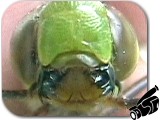 Watch
a dragonfly's jaws in action. Watch
a dragonfly's jaws in action.
(Video = 0:25, 0.8 Mb.) |
|
 Classification
of Dragonflies Classification
of Dragonflies
|
| Kingdom: |
Animalia |
| Phylum: |
Arthropoda |
| Class: |
Insecta |
| Order: |
Odonata |
| Suborder: |
Anisoptera (true dragonflies) |
| Suborder: |
Zygoptera (damselflies) |
|
|
| |
Watch a higher resolution version of this video on YouTube. Click Here: Jaws in Action! |
| |
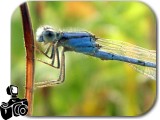 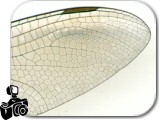 Dragonflies
have two pairs of clear wings and three pairs of legs attached
to the thorax. The wings are strengthened with net-like
veins which have a unique pattern for each species. The
thorax is slanted upwards. This brings the legs forward
for perching on upright stalks and to form a basket for
catching flying insects. Long spines on the legs help catch
prey in flight. Dragonflies rarely use their legs for walking.
The thorax, with the powerful wing muscles, can be 60% of
a dragonfly's weight. Dragonflies
have two pairs of clear wings and three pairs of legs attached
to the thorax. The wings are strengthened with net-like
veins which have a unique pattern for each species. The
thorax is slanted upwards. This brings the legs forward
for perching on upright stalks and to form a basket for
catching flying insects. Long spines on the legs help catch
prey in flight. Dragonflies rarely use their legs for walking.
The thorax, with the powerful wing muscles, can be 60% of
a dragonfly's weight.
|
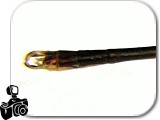 The
abdomen is long, thin and very flexible. It has 10 distinct
segments. Males have appendages on the end of the abdomen,
called claspers, to hold onto a female during mating. The
reproductive organs are located in the abdomen. The
abdomen is long, thin and very flexible. It has 10 distinct
segments. Males have appendages on the end of the abdomen,
called claspers, to hold onto a female during mating. The
reproductive organs are located in the abdomen.
|

All insects breathe through tubes called
trachea that allow air to pass directly to their inner tissues,
bringing oxygen in and taking carbon-dioxide out. The trachea
open to the outside air at holes along the thorax and abdomen
called spiracles.
Food passes from the mouth to the foregut
where it is ground up, then on to the midgut for chemical
breakdown and nutrient absorption. In the hindgut water
and minerals are absorbed and feces are passed out through
the anus.
Insects have an open circulatory system
with a simple heart, a section of vessel in the abdomen
that pumps hemolymph (insect blood) to the front of the
body. It returns to the abdomen through open sinuses.
The central nervous system is simple with
a dorsal brain and ventral nerve cord containing enlargements
called ganglia. Each ganglion is like a mini brain controlling
nerves within its region of the body. |
| 
There are two groups within the Odonata:
the true dragonflies (Suborder: Anisoptera) and the damselflies
(Suborder: Zygoptera). Here’s how to tell them apart: |
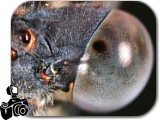 1.
Head and Eyes: In true dragonflies the head is
rounded and the compound eyes touch each other at the top
(except in one family). In damselflies, the head is wide,
almost dumbbell-shaped. The space between the compound eyes
is wider than the eye itself. 1.
Head and Eyes: In true dragonflies the head is
rounded and the compound eyes touch each other at the top
(except in one family). In damselflies, the head is wide,
almost dumbbell-shaped. The space between the compound eyes
is wider than the eye itself.
|
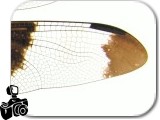 2.
Wings: Anisoptera means "unequal wings".
In true dragonflies the second pair of wings is broader
than the first. A dragonfly at rest spreads its wings apart,
like a moth. Zygoptera means "equal wings". Both
pairs of a damselfly's wings are similar. At rest, most
damselflies hold their wings together, above the body, like
a butterfly. 2.
Wings: Anisoptera means "unequal wings".
In true dragonflies the second pair of wings is broader
than the first. A dragonfly at rest spreads its wings apart,
like a moth. Zygoptera means "equal wings". Both
pairs of a damselfly's wings are similar. At rest, most
damselflies hold their wings together, above the body, like
a butterfly.
|
3. Shape and Flight: Dragonflies
are usually larger and stouter than damselflies and they
fly strongly, out in the open. Damselflies have very slender
bodies and are weaker flyers, usually fluttering near the
ground or by thick vegetation. |
|  For
convenience, the word “dragonfly” is used
here to refer to both dragonflies and damselflies
most of the time. For
convenience, the word “dragonfly” is used
here to refer to both dragonflies and damselflies
most of the time.
|
|
|

Fly back to NatureNorth.com |